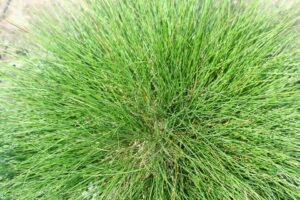For those in the market for a genuine cool season all-rounder, look no further – you can’t get much more utilitarian than Fescue.
It’s as hardy a cool season grass as you’ll find, making it perfect for the eminently changeable seasons that much of the more temperate and cooler regions of Australia experience. If you need a grass that will stand up to a stiff frost in winter and get through a major dry spell in summer, you could do far worse than jump on the Fescue bandwagon.
Fescue is a traditionally coarse and long growing grass. Its flexibility isn’t just contained to the conditions it can survive; it can also be cut low and be kept as a lawn, or it can be allowed to grow free and be grazed on by livestock. Depending on which variety of Fescue you choose, the natural growing height can vary anywhere from 10cm-200cm.
Fescue is very closely related to Ryegrass, and shares a lot of key features to the genus. It is also one of the only grasses that can be found on every continent bar Antarctica – yet another verification of its ability to survive a variety of conditions.
So is Fescue the grass for you? Let’s look at what makes this grass tick.
Pros
As mentioned, when it comes to Australia’s cooler climes, the hardiness of Fescue is nigh-on unbeatable. Its ability to withstand frosts make it the ideal candidate for Tasmania and Southern Victoria, and its ability to cope with extended dry spells also make is ideal for the Southern regions of Western and South Australia.
Fescue is also a particularly low maintenance grass. More often than not, the areas that it is grown in have enough rain to keep it going, and you’ll only need to water it during the most taxing dry spells. Its drought resistance is due to the deep root system of the plant, which can dive down to depths of 6 feet, accessing moisture from the water table.
Fescue will also putt along just fine in a low fertility soil, although the better quality the soil, the better the turf will look. While fertiliser normally isn’t a must, it will enjoy a meal of nitrogen if given the option.
Not being an exceptionally fast growing plant, mowing isn’t a job that you’ll have to worry about every weekend. It is important to keep in mind that Fescue prefers to be cut relatively high – 7-10cm – as cutting anywhere below that height can dry the grass’s sod out, causing thinning.
Cons
A concern that is often raised regarding Fescue is the coarseness of the bristles. The scratchiness of the grass could be seen as a trade-off for its hardiness, and can be a little rough for the kids if they’re rolling about on it.
Fescue also has a susceptibility to pests and diseases, particularly after heavy rains or if the soil is waterlogged – great conditions for unwanted visitors to thrive. A preventative fungicide treatment may be worth a look if your area is prone to these sorts of conditions.
Varieties
Mckay’s offer two separate types of pure Fescue – McKays’ Turf-Type Tall Fescue and McKays’ RTF Tall Fescue; and one Fescue blend – McKays’ Parks Blend (a Kentucky/Fescue mix).
McKays’ Turf-Type Tall Fescue is your traditional Fescue option, with all the pluses offered by Fescue listed above. It’s as popular a choice for Australian homes as ever, with the benefits of the grass coming at an economical price.
McKays’ RTF Tall Fescue is by-and-large a traditional Fescue, but with the added ability to efficiently repair itself. A great option for lawns that will experience a bit of wear and tear.
McKays’ Parks Blend is a combination of 50 percent Fescue, 40 percent Kentucky Bluegrass and 10 percent slow release fertiliser that was custom made to suit the needs of Australian parks and recreation areas.
No matter where you are in Australia, whether it’s Fescue or another variety, McKays will find a solution to your turf problem. So what are you waiting for? Consult your friendly McKays team today!



